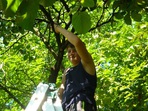Greengage Marmalade
16. říjen 2019
Greengage Marmalade
Prepared by: Lenka Hauke & Petr Hauke
Main ingredient: Greengage, Reine Claude (Prunus domestica italica)
Greengage, Reine Claude (Prunus domestica italica):
Also called gage is a fruit tree of Rosales order. The cultivars with round-shaped fruit are also commonly called green-gage or just gage. Reine Claude belongs to plum trees, which fruits improve the function of intestine due to its high fibrous material content. Other positive effects include also reduction of blood pressure. They are also a source of B vitamins, as well as vitamin C, A, E and a number of minerals (potassium, phosphorus, iron and calcium).
Since this year’s harvest was very rich, we processed the fruit in many ways - as fresh, in soufflé and various cakes. However, we transform most of fruits into marmalade. Although the fruit itself has a quite large content of pectin, I must confess, we also use gelling sugar for better consistency of the marmalade.
And here is our recipe:
Ingredients:
3 kg of ripe Reine Claude fruit (can be also overripe that boil to a mash better, but not spoiled
500 g of gelling sugar (the best we use 3:1)
Procedure:
First it was necessary to harvest the fruit. Our children diligently acquitted this task.
(Well, I must say that work safety is sometimes a total stranger to them. Fortunately everything went without any accidents.)
Then we pour the fruit in a sink, separate any spoiled pieces and wash thoroughly.
The basic is to have only healthy fruit, free of any rotting.
After that the children got involved again. You need to halve each piece. If the gage stone comes right out, put it away. If not, leave it.
We usually boil the fruit for marmalade with the stone left, it doesn’t hurt anything.
Then boil and boil in a large enough pot, until the fruit is boiled to a mash.
Once the fruit in a pot lets out its own juice, it is no longer necessary to keep stirring all the time and in the meantime you can enjoy a cup of coffee J.
After you obtain mash matter, use a suitable utensil to pass the mash through a sieve for separating gage stones and peels.
If we don’t have anything else that would be more suitable for this task, we can use a scoop.
We weight the resulting mass so we know how much of gelling sugar to add.
This year the fruit was very sweet since it had a lot of sunlight during ripening, so we add just 500 g of gelling sugar per 3 kg of the mass (after passing the mash through the sieve for separating gage stones).
(Usual ratio the gelling sugar producer indicates is 1,500 g of fruit + 500 g of sugar + 500 g of gelling sugar).
After that we boil again, for at least 5 minutes after the gelling sugar dissolves. During the boiling process, remove continuously any “foam” that creates on the surface. We collect the foam because it reduces the lifetime of the marmalade. We collect it in a dish for further use, for example as a spread on a bun, or just eat it as it is.
You are almost done - just pour the hot marmalade in thoroughly washed and dried fruit jars.
Don’t forget to clean the rim.
And put the lid on tightly.
Then turn the jars upside down for about 5 minutes. The lid tightens due to a hot substance and better keeps the air out.
We let full jars to cool down packed in an old blanket.
And the only thing you need to do at the end is to find a place for storing your jars and enjoy them in the wintertime J
And to make it complete… you might ask what to do with the leftovers - the gage stones and the fruit pulp?
In our house it’s very simple … our hens are just omnivores


















